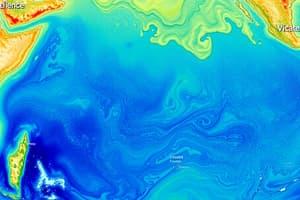Podcast
Questions and Answers
What are ocean currents and what factors drive their movement?
What are ocean currents and what factors drive their movement?
Ocean currents are large-scale movements of seawater driven by wind, water density differences, and the Earth's rotation.
Differentiate between surface currents and deep water currents.
Differentiate between surface currents and deep water currents.
Surface currents occur in the upper 400 meters of the ocean and are primarily caused by wind, while deep water currents are driven by density differences resulting from temperature changes.
How does the Coriolis Effect influence ocean currents?
How does the Coriolis Effect influence ocean currents?
The Coriolis Effect causes ocean currents to deflect to the right in the Northern Hemisphere and to the left in the Southern Hemisphere.
What role do temperature and salinity play in the movement of deep water currents?
What role do temperature and salinity play in the movement of deep water currents?
What are the differences between warm and cold ocean currents, and give examples of each?
What are the differences between warm and cold ocean currents, and give examples of each?
Explain how ocean currents can affect marine life.
Explain how ocean currents can affect marine life.
How do ocean currents influence climate regulation?
How do ocean currents influence climate regulation?
What potential impacts of climate change on ocean currents have been identified?
What potential impacts of climate change on ocean currents have been identified?
Flashcards are hidden until you start studying
Study Notes
Ocean Currents
-
Definition: Ocean currents are large-scale movements of seawater, driven by various factors, including wind, water density differences, and the Earth's rotation.
-
Types of Ocean Currents:
-
Surface Currents:
- Caused by wind blowing over the ocean surface.
- Generally occur in the upper 400 meters of the ocean.
- Examples: Gulf Stream, Kuroshio Current.
-
Deep Water Currents:
- Driven by density differences due to temperature (thermohaline circulation).
- Involve the movement of water from the poles to the equator and vice versa.
- Play a critical role in global climate regulation.
-
-
Driving Forces:
- Wind: Surface currents are primarily propelled by prevailing winds.
- Coriolis Effect: Causes currents to deflect to the right in the Northern Hemisphere and to the left in the Southern Hemisphere.
- Temperature and Salinity: Variations lead to density differences, influencing deep water circulation.
- Earth’s Rotation: Influences the direction and speed of currents.
-
Major Ocean Currents:
-
Warm Currents:
- Examples: Gulf Stream (Atlantic), Agulhas Current (Indian Ocean).
- Transport warm water from equatorial regions towards the poles.
-
Cold Currents:
- Examples: California Current (Pacific), Canary Current (Atlantic).
- Bring cooler water from polar regions towards the equator.
-
-
Effects of Ocean Currents:
- Climate Regulation: Influence regional climates; warm currents can lead to milder weather, while cold currents can promote cooler climates.
- Marine Life: Currents affect nutrient distribution, impacting ecosystems and fish populations.
- Navigation and Shipping: Currents can aid or hinder maritime travel, influencing shipping routes.
-
Climate Change Impact:
- Alterations in temperature and salinity can disrupt current patterns, potentially leading to significant changes in global climate and marine ecosystems.
- Melting polar ice and changing atmospheric conditions may impact the thermohaline circulation.
Ocean Currents Overview
- Ocean currents are large-scale movements of seawater, influenced by wind, water density differences, and the Earth's rotation.
Types of Ocean Currents
-
Surface Currents:
- Produced by wind interacting with the ocean surface.
- Typically occur in the upper 400 meters of the ocean.
- Notable examples include the Gulf Stream and Kuroshio Current.
-
Deep Water Currents:
- Driven by differences in water density caused by temperature variations (known as thermohaline circulation).
- Involve water movement from polar regions toward the equator and vice versa.
- Play a crucial role in regulating the global climate.
Driving Forces of Ocean Currents
- Wind: The primary force driving surface currents through prevailing wind patterns.
- Coriolis Effect: A phenomenon that causes currents to deflect to the right in the Northern Hemisphere and to the left in the Southern Hemisphere.
- Temperature and Salinity: Differences in temperature and salinity create density variations, influencing the flow of deep water currents.
- Earth's Rotation: Affects the direction and velocity of currents.
Major Ocean Currents
-
Warm Currents:
- Examples: Gulf Stream (Atlantic Ocean) and Agulhas Current (Indian Ocean).
- Transport warm water from equatorial regions towards the poles, contributing to milder regional climates.
-
Cold Currents:
- Examples: California Current (Pacific Ocean) and Canary Current (Atlantic Ocean).
- Move cooler water from polar regions toward the equator, often leading to cooler climates in affected areas.
Effects of Ocean Currents
- Climate Regulation: Currents significantly influence regional climates; warm currents can create milder weather, while cold currents can lead to cooler conditions.
- Marine Life: Currents impact nutrient distribution, which is vital for maintaining healthy ecosystems and fish populations.
- Navigation and Shipping: Currents can either facilitate or obstruct maritime travel, significantly affecting shipping routes.
Climate Change Impact
- Changes in temperature and salinity can disrupt existing ocean current patterns.
- Alterations may lead to major shifts in global climate and marine ecosystems.
- Melting polar ice and variations in atmospheric conditions are likely to affect thermohaline circulation.
Studying That Suits You
Use AI to generate personalized quizzes and flashcards to suit your learning preferences.




